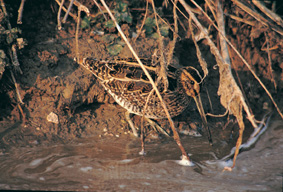
A new study by The Game Conservancy Trust, which will be published in the July edition of the international science journal Bird Study, published by the British Trust for Ornithology (BTO), highlights the threat that land drainage can have on important wader bird species, particularly common snipe.
The common snipe is a particular favourite of bird-watchers, especially during the breeding season when males can be heard giving their 'drumming' or 'beating' display on spring mornings and evenings.
However, these small waders, recognizable by their 6.5cms long straight bills that are used for probing wet grassland for prey, have declined by about 62% over the past 20 years in lowland Britain due to the loss or deterioration of their wetland habitat. As a consequence they are now designated an Amber List species.
To understand whether snipe are fairing better in upland areas, the Trust's study investigated both habitat use and the food preferences of breeding snipe Gallinago gallinago on moorland in northern England. This scientific study is part of The Trust's long-term Upland Predation Experiment, which is investigating the effects of predation on breeding populations of upland waders, such as golden plover, lapwing and curlew.
On lowland wet grassland, the snipe's breeding season is determined by the duration for which the soil remains soft enough for the birds to probe for food such as earthworms and tipulid larvae (daddy long legs or mosquito larvae).
However, since the 1940s the serious population decline in lowland areas has been driven by the loss of this soft wet grassland habitat through increased land drainage aimed at creating more arable land, as well as increased livestock grazing.
On Britain's moorland, however, the study revealed that densities of snipe were comparable to those in the best lowland habitats in England and Wales. Moorland is clearly an important habitat for the British snipe population, notably because it is far more extensive than the remaining suitable lowland habitats. The availability of suitable wetland feeding areas on moorland appears to be the main factor determining breeding densities.
However, between 1980 and 1990 the number of sheep in the uplands more than doubled, resulting in a shift from heather-dominated habitats to heather/grass mosaics in many areas. Although this might have made some moors marginally more attractive to breeding snipe, it is likely to have resulted in increased trampling rates of snipe nests - one of the major factors that caused snipe to decline in lowland wet grasslands. In addition, the agricultural improvement of pasture fields adjoining moorland is detrimental to most breeding waders, including snipe, and improved grass held the lowest snipe densities within the study sites.
Dr Andrew Hoodless, carried out this research on The Game Conservancy Trust's study sites at Otterburn in Northumberland and said, "Because of its specialist feeding requirements, snipe are very susceptible to habitat change. Given the poor status of breeding snipe in lowland Britain and the emerging evidence of declines on upland marginal grassland, we need to ensure that any future upland habitat management practices are beneficial to snipe and do not result in further deterioration of their important moorland habitats."
